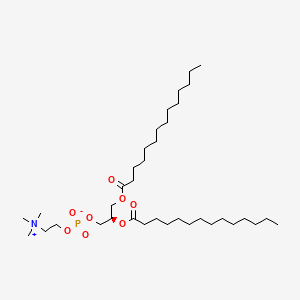18194-24-6
18194-24-6 is a lipid of Glycerophospholipids (GP) class. 18194-24-6 is associated with abnormalities such as Cerebrovascular accident, Renal tubular disorder, Atherosclerosis, Hyperlipoproteinemia Type III and Lipid Metabolism Disorders. The involved functions are known as Process, protein folding, Catalyst, Biochemical Pathway and Fold in Medical Device Material. 18194-24-6 often locates in Tissue membrane, Membrane, periplasm, vesicle membrane and outer membrane. The associated genes with 18194-24-6 are Integral Membrane Proteins, Protein Structure, RTN4 gene, RTN4R gene and Protein, Organized by Structure. The related lipids are Micelles, dimyristoylphosphatidylglycerol, 1,2-dihexadecyl-sn-glycero-3-phosphocholine, Unilamellar Vesicles and cholesteryl oleate. The related experimental models are Mouse Model, Arthritis, Adjuvant-Induced, Disease model and Xenograft Model.
References related to lipids published in J. Biol. Chem.
| PMID | Journal | Published Date | Author | Title |
|---|---|---|---|---|
| 7499313 | J. Biol. Chem. | 1995 | Surrey T and Jähnig F | Kinetics of folding and membrane insertion of a beta-barrel membrane protein. |
| 9312118 | J. Biol. Chem. | 1997 | Wang Y et al. | Identification of shallow and deep membrane-penetrating forms of diphtheria toxin T domain that are regulated by protein concentration and bilayer width. |
| 7829491 | J. Biol. Chem. | 1995 | Mishra VK et al. | Effect of the arrangement of tandem repeating units of class A amphipathic alpha-helixes on lipid interaction. |
| 10419496 | J. Biol. Chem. | 1999 | Weers PM et al. | Interaction of an exchangeable apolipoprotein with phospholipid vesicles and lipoprotein particles. Role of leucines 32, 34, and 95 in Locusta migratoria apolipophorin III. |
| 11279152 | J. Biol. Chem. | 2001 | Christensen K et al. | Binding of steroidogenic acute regulatory protein to synthetic membranes suggests an active molten globule. |
| 12393895 | J. Biol. Chem. | 2002 | Morrow JA et al. | Apolipoprotein E4 forms a molten globule. A potential basis for its association with disease. |
| 12670959 | J. Biol. Chem. | 2003 | Zhang W et al. | Binding of peptides with basic and aromatic residues to bilayer membranes: phenylalanine in the myristoylated alanine-rich C kinase substrate effector domain penetrates into the hydrophobic core of the bilayer. |
| 12684504 | J. Biol. Chem. | 2003 | Kiss RS et al. | Structure-guided protein engineering modulates helix bundle exchangeable apolipoprotein properties. |
| 10567370 | J. Biol. Chem. | 1999 | Shen YM et al. | Lipid-dependent activation of protein kinase C-alpha by normal alcohols. |
| 18845546 | J. Biol. Chem. | 2008 | Mishra VK et al. | Effect of leucine to phenylalanine substitution on the nonpolar face of a class A amphipathic helical peptide on its interaction with lipid: high resolution solution NMR studies of 4F-dimyristoylphosphatidylcholine discoidal complex. |
| 15485851 | J. Biol. Chem. | 2004 | Bender V et al. | T cell antigen receptor peptide-lipid membrane interactions using surface plasmon resonance. |
| 16877761 | J. Biol. Chem. | 2006 | Tremouilhac P et al. | Synergistic transmembrane alignment of the antimicrobial heterodimer PGLa/magainin. |
| 16159879 | J. Biol. Chem. | 2005 | Pearson K et al. | Specific sequences in the N and C termini of apolipoprotein A-IV modulate its conformation and lipid association. |
| 25398882 | J. Biol. Chem. | 2015 | Smrt ST et al. | The influenza hemagglutinin fusion domain is an amphipathic helical hairpin that functions by inducing membrane curvature. |
